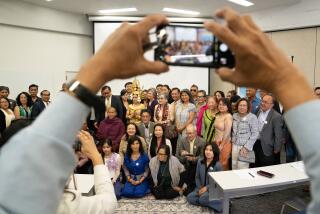Cambodia’s graft culture
- Share via
PHNOM PENH, CAMBODIA — Before leaving for Chompovon Primary School on the outskirts of the capital, students say, their parents give them 10 to 15 cents of pocket money. That’s enough to buy some breakfast cakes and rice -- and pay their teachers a few cents before they walk into class.
The fee, a widespread practice in Cambodia’s public schools, is a kind of informal toll that students must pay. If they don’t, parents say, they risk receiving a lower grade or even being demoted.
Here, schoolchildren are taught at an early age what it takes to get ahead. And it only gets worse as they grow up. At every turn, Cambodians pay under the table: for a birth certificate, a travel visa, a fair ruling from a judge.
Transparency International, a corruption-fighting organization based in Berlin, says the majority of Cambodia’s public servants earn their living by collecting bribes.
In recent years, many things have improved in Cambodia, particularly its economy, which has grown by more than 10% annually. Analysts say those gains will probably give Prime Minister Hun Sen’s party a commanding victory in today’s parliamentary elections.
But when it comes to corruption, there has been virtually no improvement, say businesspeople, Western diplomats, foreign relief workers and Cambodian citizens. The country has consistently been ranked as among the most graft-ridden in the world, and some say that the situation may have gotten worse with the economic resurgence.
“When things start to boom, people start to get a little more greedy,” said John Brinsden, vice chairman of Acleda Bank, a locally owned lender with branches throughout Cambodia.
The nation’s key industries are garment manufacturing and tourism, but investments from China, South Korea and other countries have increased dramatically, leading to a burst of development in Phnom Penh, around the Angkor temple complex and along tourist coastlines. Property prices have skyrocketed.
Brinsden says he sees a growing middle class, but a third of the population still lives under the poverty line, and the global rise in food and fuel prices threatens to reverse some of the recent gains.
Poverty is a key factor in widespread corruption in this country, which is still recovering from the genocide under Pol Pot and the Khmer Rouge from 1975 to 1979, when an estimated 1.7 million people died from executions as well as starvation, overwork and other abuses.
Cambodians and foreigners alike here charge that Hun Sen, a former Khmer Rouge fighter, and his Cambodian People’s Party have perpetuated corruption with their patronage system, culture of backroom dealing and lack of transparency.
During the election campaign, Hun Sen and candidates with 11 opposition parties pledged support for an anti-corruption law, something that Western relief groups and foreign governments have urged. But it isn’t clear when such a law may be enacted or whether it would meet international standards, including requirements that government officials and military leaders disclose their assets.
Cambodians have become accustomed to corrupt behavior at all levels. But many abhor it, especially the way it has permeated schools. Besides paying petty bribes, schoolchildren learn to lie because they are ashamed or are told by teachers not to talk about such practices.
During recess on a hot July afternoon, several fifth-graders at Chompovon sat under a tapang, or umbrella tree. A sign posted on the trunk read: “We have to help grow the trees.” None of the students were willing to say how much they were paying their teachers -- and some said there was no such practice.
Jip Sovon, a deputy director of the school, acknowledged that children gave their teachers 100 riel, the equivalent of 2 or 3 cents, every day. But he insisted that the fees weren’t mandatory.
“The teachers still allow them to go into class and treat them fairly,” he said.
But parents in the neighborhood told a different story.
Until two years ago, Em Sophan had two children attending Chompovon. He said his children paid 200 riel a day each. “Any students who pay are given good scores; those who don’t pay get lower scores,” he said.
Em said his children quit school after sixth grade because they were told to come up with $100 for a test to move on to secondary school.
“That’s a lot of money. My children decided to stop because I can’t afford it,” Em said, squatting outside his one-room house, built in traditional Cambodian style on 6-foot stilts.
Em sells vinyl caps for a living, making a little more than $2 a day. On a weekday afternoon, his two children were on the streets, one peddling bottled water and the other decals for motorbikes. Down the street, a billboard said: “Every child must be in school, not at work.”
Jip, the school’s deputy director, said he too hated the system. But he said Cambodian public schools don’t pay a living wage. At his school, teachers make on average $25 to $30 a month, and that’s after a 15% increase in the last year. Jip said that he has been at the school since it reopened in 1979 and that he earns about $37 monthly.
“We have seen students look down on teachers,” he said, “because students think that if they don’t pay, the teachers cannot teach.”
--
More to Read
Sign up for Essential California
The most important California stories and recommendations in your inbox every morning.
You may occasionally receive promotional content from the Los Angeles Times.











